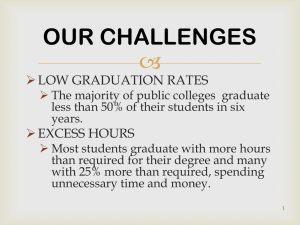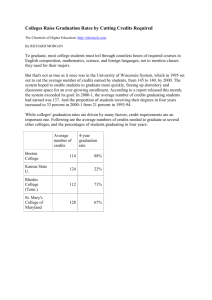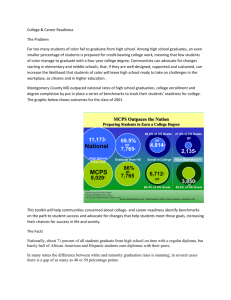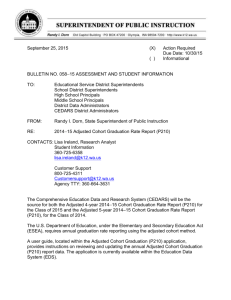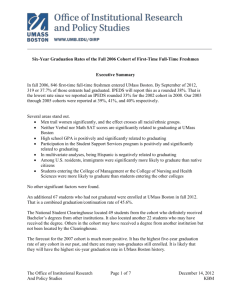presentation to Student Affairs Strategic Plan Working Group
advertisement
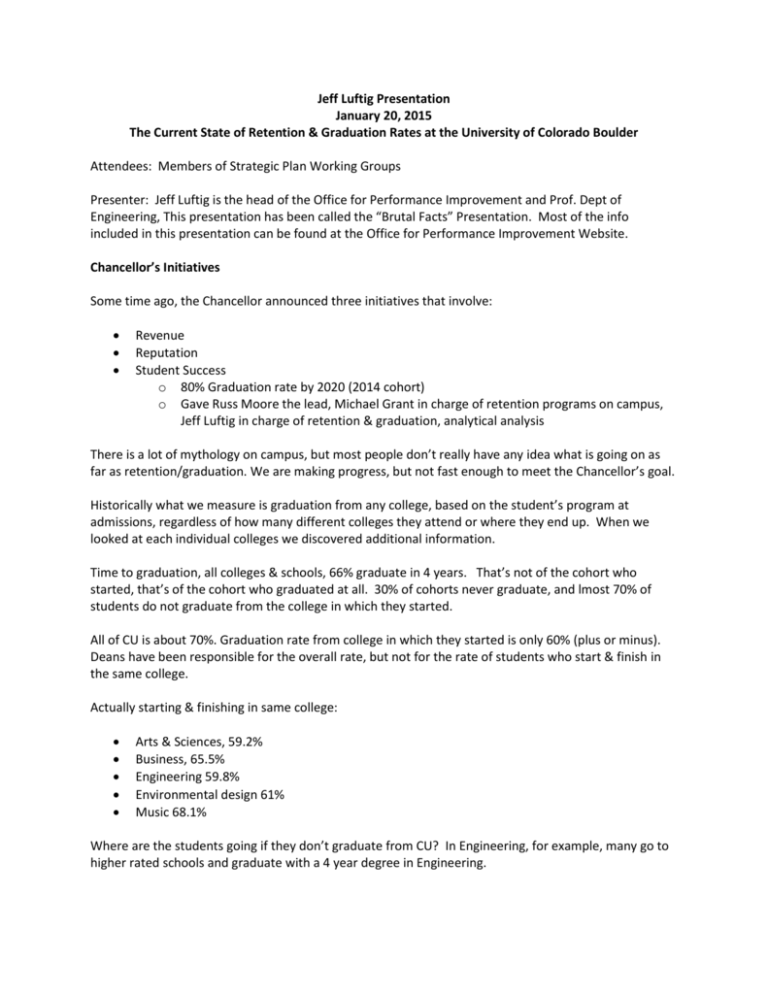
Jeff Luftig Presentation January 20, 2015 The Current State of Retention & Graduation Rates at the University of Colorado Boulder Attendees: Members of Strategic Plan Working Groups Presenter: Jeff Luftig is the head of the Office for Performance Improvement and Prof. Dept of Engineering, This presentation has been called the “Brutal Facts” Presentation. Most of the info included in this presentation can be found at the Office for Performance Improvement Website. Chancellor’s Initiatives Some time ago, the Chancellor announced three initiatives that involve: Revenue Reputation Student Success o 80% Graduation rate by 2020 (2014 cohort) o Gave Russ Moore the lead, Michael Grant in charge of retention programs on campus, Jeff Luftig in charge of retention & graduation, analytical analysis There is a lot of mythology on campus, but most people don’t really have any idea what is going on as far as retention/graduation. We are making progress, but not fast enough to meet the Chancellor’s goal. Historically what we measure is graduation from any college, based on the student’s program at admissions, regardless of how many different colleges they attend or where they end up. When we looked at each individual colleges we discovered additional information. Time to graduation, all colleges & schools, 66% graduate in 4 years. That’s not of the cohort who started, that’s of the cohort who graduated at all. 30% of cohorts never graduate, and lmost 70% of students do not graduate from the college in which they started. All of CU is about 70%. Graduation rate from college in which they started is only 60% (plus or minus). Deans have been responsible for the overall rate, but not for the rate of students who start & finish in the same college. Actually starting & finishing in same college: Arts & Sciences, 59.2% Business, 65.5% Engineering 59.8% Environmental design 61% Music 68.1% Where are the students going if they don’t graduate from CU? In Engineering, for example, many go to higher rated schools and graduate with a 4 year degree in Engineering. Deans need to be responsible for the success of students who come into the college. If the students are not going to do well in the original college, there has been no concern about where the students go…do they go to another college at CU? Counseling students to move to other colleges within CU. Graduation/Retention Statistics If we hit 80%, we will be at the median of our sister institutions. This is not something that can’t be done. We looked at the last 10 cohorts we have been improving at .361%. At this rate, the first cohort at an 80% rate, will be in 2038. In 2045, we’ll have an 80% graduate rate at our current rate of improvement. The numbers predict that our 6 year graduation rate for the current cohort will be about 70%. The required change is about 2%, which means we will have to change the rate of improvement by 5.5 times. I think we can all agree that we’re somewhat siloed. (Our campus has been named as within the top 10 resistant to change.) We lose more students in our first year than any other year. We lose 16% in the first year. If you lose 16% in the first year, 80% graduation rate is impossible. We have to retain 95% in the first year to reach 80%. % of student who leave CU 16% first year 7% second year 2% third year 7% fourth to sixth year Who Leaves? Academic Probation In CAS at the end of the first year, you can count on 20% of the students being on academic probation. If a student is on academic probation, 40+% were likely to leave CU. Students in CAS make up 1/3 of the students we lose. My question is “What is academic probation, what is the purpose and how do we get students off it to retain them.” Demographic variables We need to determine who’s going to do well, who’s going to do poorly. PGPA does NOT work! First you choose something that doesn’t matter and then you do it poorly. Who cares what their GPA is, we want to know who’s going to be here. What are the most important factors or variables? o High school GPA - less than 2.96 is high risk, There’s a 62% chance you’ll leave after the first year o Housing completion date, after June 1 Student who complete housing applications late end up in Williams Village. o o Mythology is that these folks are procrastinators, but really the largest predictor is ethnic group, Hispanics, black students apply later. Next predictor is First Gen. We take these students with fewer tools and put them together in Williams Village. Students in the exact same background in other dorms did better than those in Williams Village There are groups of states whose students don’t do well. The overall (composite) ALEX score is a terrible predictor, even worse than PGPA, but the component parts can predict success, depending upon the major. o What Next? “Doing things is not the same as getting things done.” For example, the BFA Mentoring Program, while a great program, self-selects for students who don’t necessarily need mentoring. We are doing a lot of planning, but everything is not going to be equally effective, some things are not going to be hugely effective and there is always a lag period. The only thing you could do that will have immediate results is to give everyone an A in every class. What I’d like to see is when we admit the fall cohort, we use the IDs to run that through our predictive algorithms to figure out which are the high risk students, and we contact those students/parents before they ever reach campus. We create a Mentoring Tomorrow’s Leaders Program (or some such name) and we’re waiting for those kids before they ever get to campus. Lowest 25% have a mentor meeting with them right away, but we want advisors and others to be able to find out about these students as they are meeting with them, to know they are higher risk and to take some extra time whenever they have questions or concerns. Every adult is a part of the equation in mentoring students. The real issue is that the students feel there is someone who cares about them.

